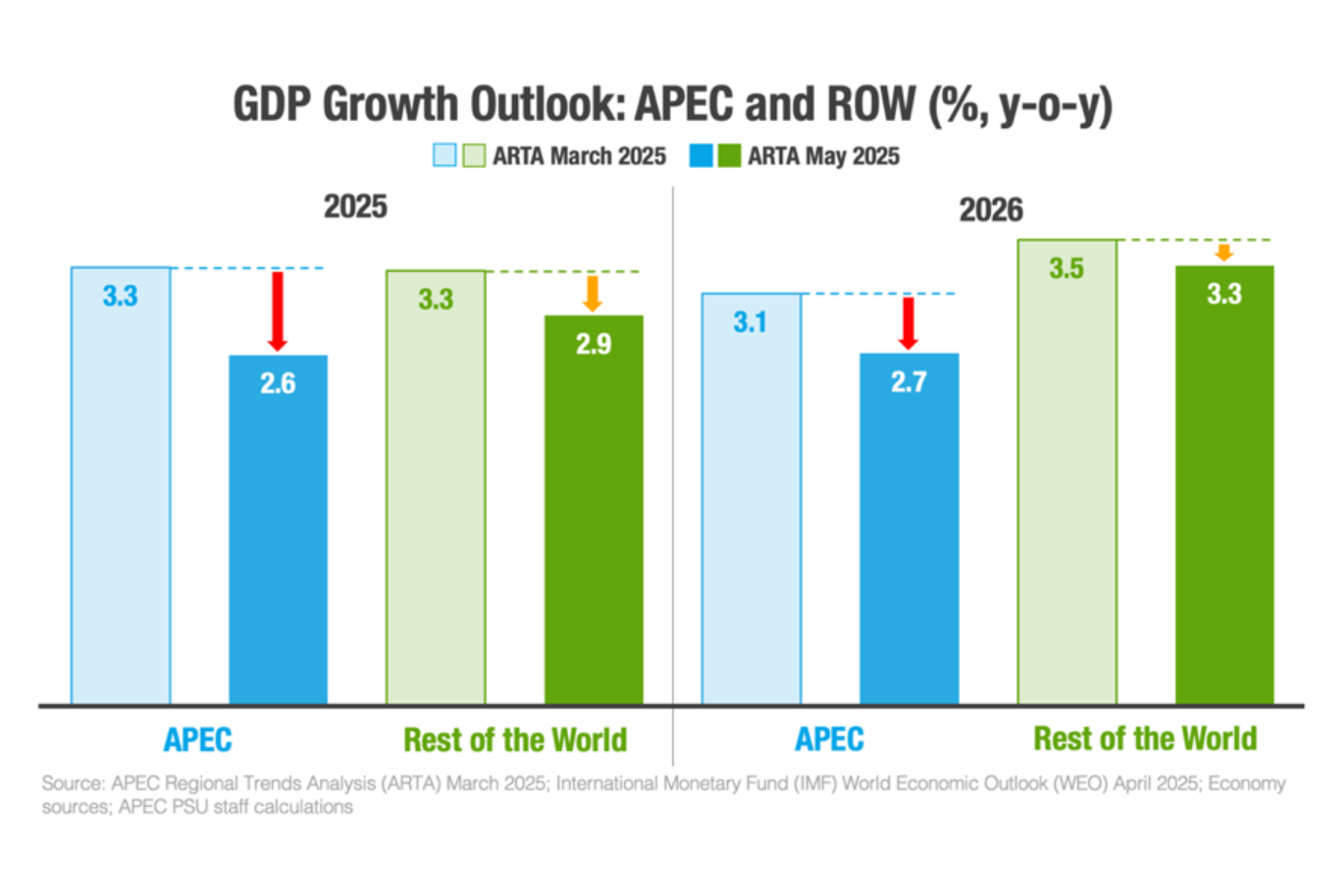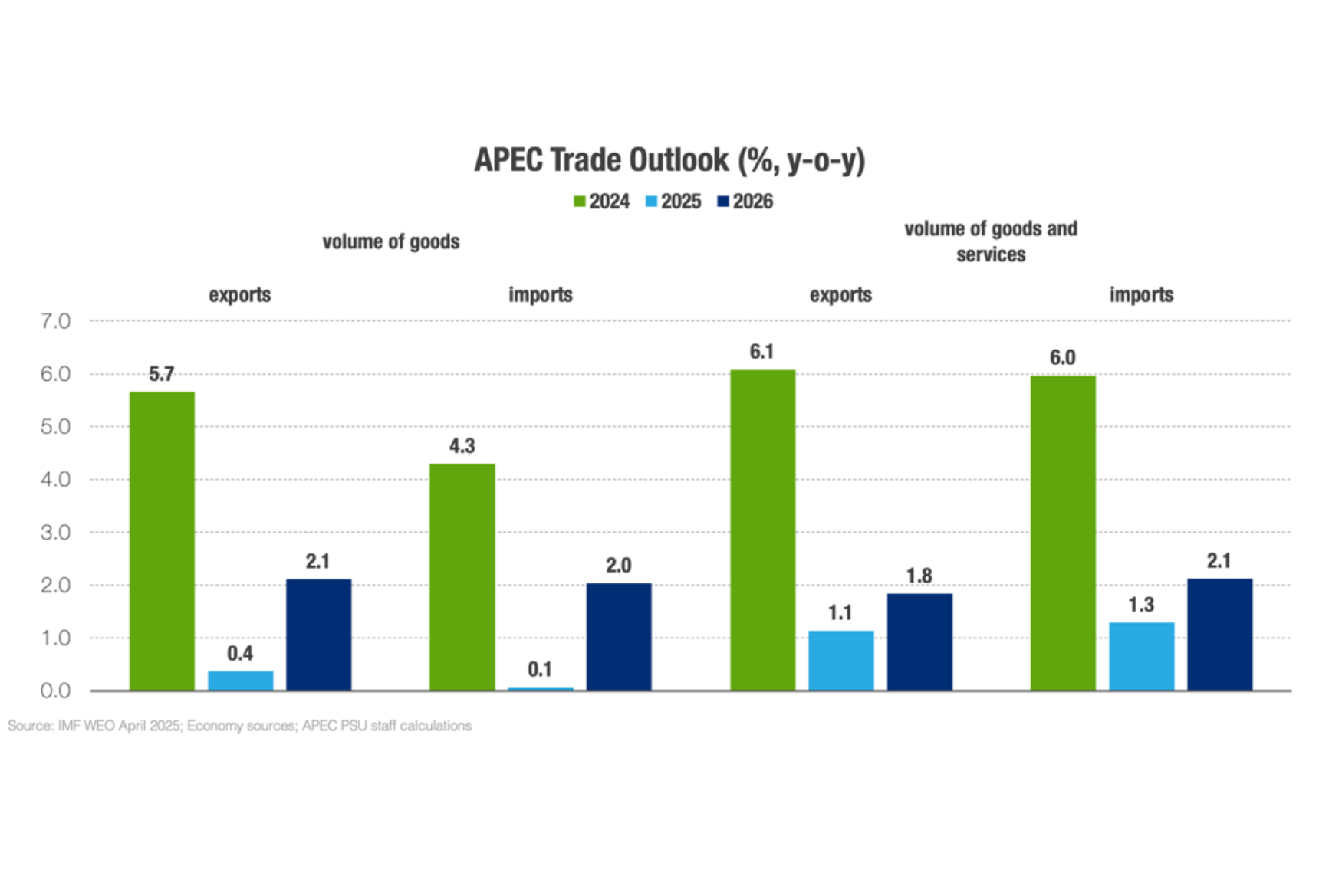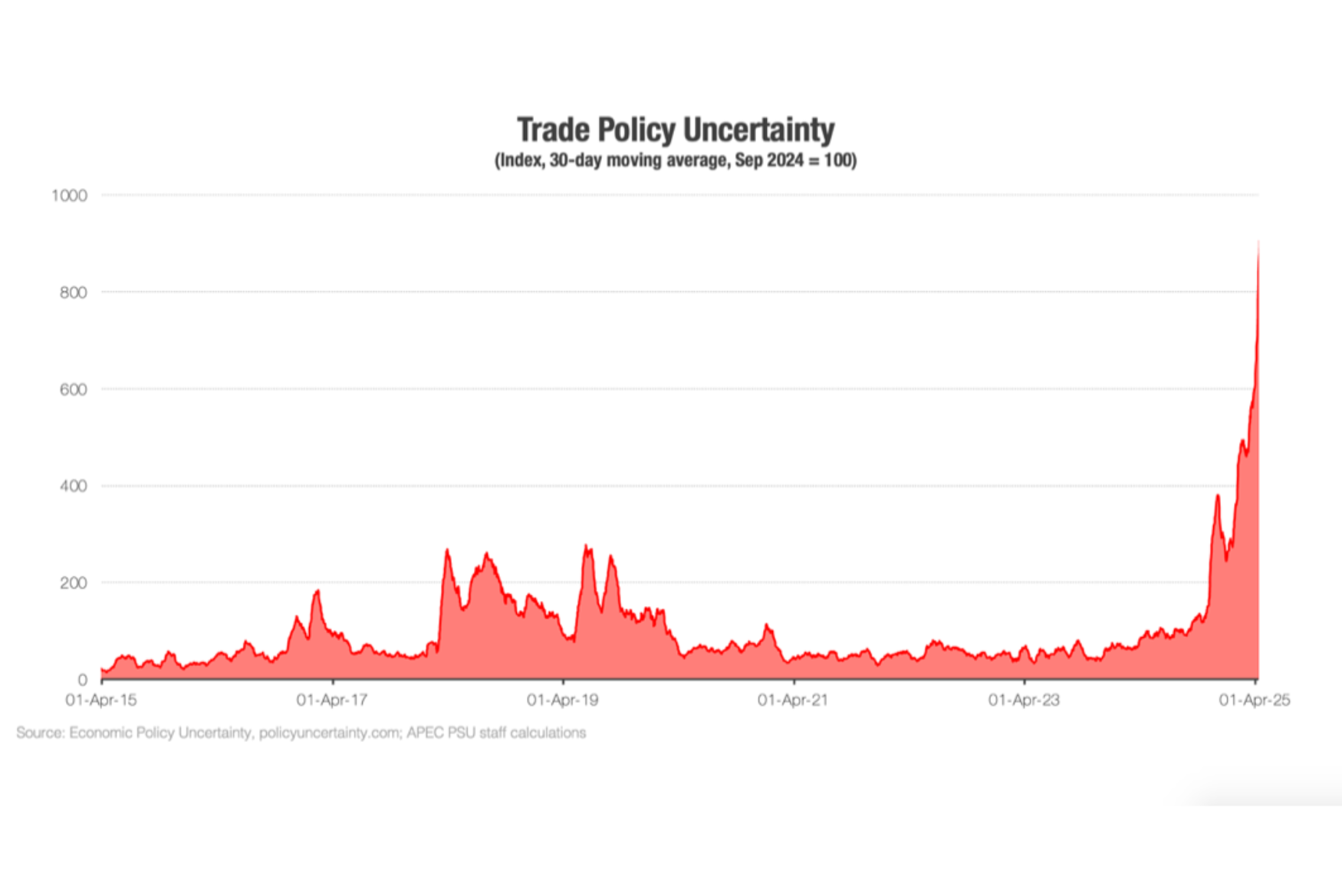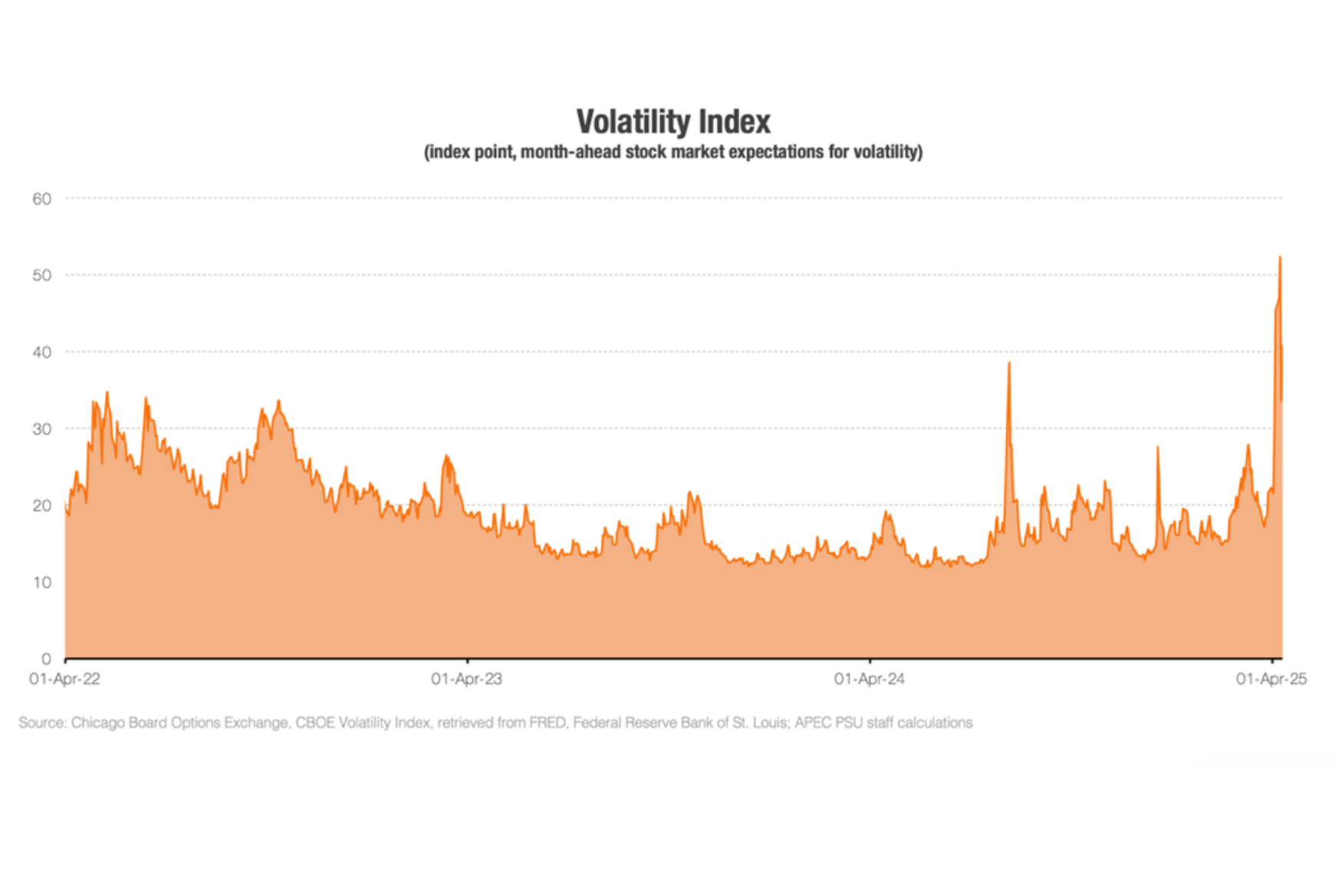
The global economy in 2025 is navigating a complex and volatile environment. Escalating trade tensions, rising protectionism and shifting supply chains are reshaping the growth landscape, particularly in the APEC region, and urging policymakers to adapt swiftly.
Growth Outlook Weakens amid Uncertainty
 APEC economies are seeing a sharper downgrade in growth than the rest of the world. Regional GDP growth is projected to slow significantly to 2.6-2.7 percent in 2025-2026, down from 3.6 percent in 2024. These projections are notably lower than the 3.1-3.3 percent forecasts in the March 2025 APEC Regional Trends Analysis (ARTA), highlighting how rising trade tensions and heightened uncertainty are undermining the recovery.
APEC economies are seeing a sharper downgrade in growth than the rest of the world. Regional GDP growth is projected to slow significantly to 2.6-2.7 percent in 2025-2026, down from 3.6 percent in 2024. These projections are notably lower than the 3.1-3.3 percent forecasts in the March 2025 APEC Regional Trends Analysis (ARTA), highlighting how rising trade tensions and heightened uncertainty are undermining the recovery.
Monetary policy rates hold steady as economies closely monitor inflation and exchange rate pressures amid global headwinds. Oil prices are falling on oversupply and subdued demand, while food prices remain stable, supported by balanced production and steady consumption.
Although a global recession remains unlikely, persistent economic uncertainty is weighing heavily on trade flows, investments and long-term decision-making. Businesses have put on hold investment decisions, including the launch of new products and strategies, affecting not only trade in goods, but also in services.
Trade Contraction Clouds Regional Prospects
The global trade environment is expected to deteriorate in 2025. Merchandise trade volume growth is now projected to turn negative, from an expected 3.0 percent expansion to a contraction of -0.2 percent.[1] Growth in commercial services exports has also been revised downward, from 5.1 percent to 4.0 percent.
Within APEC, the volume of goods and services exports is expected to grow by just 1.1 percent in 2025 on average, a sharp reduction from 6.1 percent in 2024.
 While many APEC economies continue to pursue trade-facilitating policies-aimed at streamlining cross-border flows and supporting domestic sectors-these efforts are increasingly offset by a surge in restrictive and discriminatory measures. According to the Global Trade Alert database, the use of subsidies rose to 14,498 cases in 2024 from 12,733 in 2022, alongside other non-tariff measures.
While many APEC economies continue to pursue trade-facilitating policies-aimed at streamlining cross-border flows and supporting domestic sectors-these efforts are increasingly offset by a surge in restrictive and discriminatory measures. According to the Global Trade Alert database, the use of subsidies rose to 14,498 cases in 2024 from 12,733 in 2022, alongside other non-tariff measures.
At the same time, trade remedies such as anti-dumping measures and countervailing duties are becoming more common, reflecting growing concerns among APEC economies about unfair trade conditions.
The shift toward a more nuanced trade policy could yield mixed outcomes. Indeed, the export outlook across APEC economies is increasingly uneven, shaped by shifting global dynamics and robust demand in certain sectors, while widespread trade uncertainties cast a long shadow over broader prospects.
Trade Policy Uncertainty Reaches Historic Highs
Indices measuring economic uncertainty have surged to unprecedented levels; in particular, the index on trade policy uncertainty went up to 900 points in 2025-a tenfold increase compared to the 2015-2024 average of 85 points.

This surge reflects escalating tariffs (and retaliatory measures), rising geopolitical tensions, and policy fragmentation, which have clouded the global trade and investment environment. Small and trade-dependent economies are especially vulnerable, facing limited resilience to external shocks. Meanwhile, the growing prioritization of domestic concerns over international cooperation threatens to heighten volatility in global markets and dampen growth.
Historical data underscores the risks: a substantial rise in tariffs correlates with significant long-term economic losses. An empirical research shows that a 10-percentage-point increase in tariffs can lower GDP by around 1.1 percent after five years, highlighting the damaging impact of protectionism on economic performance over time.[2]
Financial Market Volatility Signals Rising Risks
Financial markets are also exhibiting warning signs. The global volatility index spiked to 52 points in April 2025, more than triple the 2023-2024 average of just 16 points.

This reflects heightened concerns over trade tensions, inflation risks, and broader geopolitical instability. Investor sentiment has become more fragile, driving up demand for safe-haven assets like gold, which has soared to record levels of around USD 3,200 per troy ounce so far in early May 2025, from an average of USD 1,400 per troy ounce during the period 2010-2020. Without clearer policy signals, financial markets are likely to remain hypersensitive to shocks, further complicating investment decisions and amplifying economic risks.
Debt and Demographic Add to Long-Term Pressures
Soaring general government gross debt continues to limit fiscal space, from a pre-pandemic average of 89 percent of GDP, increasing to 103 percent of GDP during the pandemic, and expected to reach 110 percent of GDP in 2024-2030. The projected rise in public debt, surpassing the pandemic peak, underscores the need for structural reforms to balance long-term growth with rising fiscal pressures.
Adding to the ongoing challenges are demographic shifts. The APEC population is projected to decline from 3 billion today to 2.2 billion by 2100, with an ageing population and a shrinking youth base that could strain social systems, reduce workforce, and challenge growth objectives. Governments will face greater pressure to raise public expenditure in health, pension and other social support measures as the population ages, while ensuring that fiscal debt remains manageable.

Policy Imperatives for an Adaptive and Resilient Future
In light of these challenging conditions, a shift in policy strategy is urgently required. Policymakers must not only manage short-term risks but also invest in long-term structural resilience to sustain growth in an increasingly uncertain and fragmented world.
Recalibrate trade policy
- Promote trade stability: De-escalate trade tensions and reduce policy uncertainty to restore confidence in trade and investment.
- Pursue trade diversification: Expand trade partnerships, target new geographic markets, and broaden the range of export and import products to reduce vulnerability and create new opportunities for growth.
Agile monetary and fiscal policies
- Responsive monetary policy action: Adjust monetary policy swiftly to manage inflation while maintaining support for stable economic growth.
- Strategic fiscal investments: Focus fiscal policy on strategic sectors, striking a balance between long-term growth and prudent spending.
Resilience-enhancing structural reforms
- Strengthen labor markets: Promote skills development, workforce participation, and adaptability to support economic transitions.
- Boost competitiveness: Implement reforms and promote innovation to help businesses thrive amid global disruptions.
- Harness digital innovation: Invest in digital infrastructure to improve efficiency and productivity.
Revitalize multilateral cooperation
- Tackle shared challenges: Strengthen multilateral efforts to tackle shared economic challenges, including fostering continuous policy dialogue toward collective action and global stability.
- Coordinate crisis responses: Enhance global cooperation to improve resilience and responsiveness to future economic shocks.
The global economy stands at a critical juncture. Protectionist trade measures are aggravating geopolitical tensions and contributing to heightened volatility-developments that could redefine the future of trade and impact on global stability. This growing uncertainty is also dampening economic growth prospects well into the medium term. Nonetheless, with strategic and forward-looking policies-focusing on agility, resilience, and cooperation-APEC economies can navigate current challenges and emerge stronger and more competitive in a rapidly changing world.
Rhea Crisologo Hernando is analyst, Glacer Niño A. Vasquez is researcher, and Carlos Kuriyama is director at the APEC Policy Support Unit.
[1] October 2024 WTO trade forecast: https://www.wto.org/english/news_e/news24_e/stat_10oct24_e.htm; April 2025 WTO trade forecast: https://www.wto.org/english/news_e/news25_e/tfore_16apr25_e.htm
[2] Furceri et al. (2020), Are Tariffs Bad for Growth? Yes, Say Five Decades of Data from 150 Countries, Journal of Policy Modeling; APEC PSU staff calculations.






